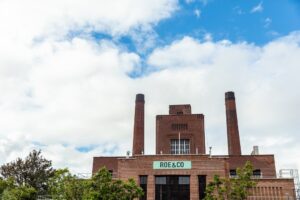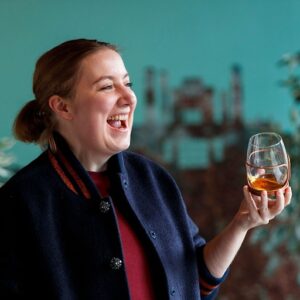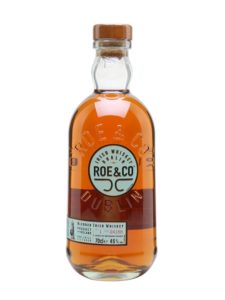By Richard Thomas
When I broke into whiskey journalism, Irish Whiskey was on the cusp of its renaissance. The number of distilleries in Ireland had increased just a few years before from three distilleries to four. Since then, the count has increased ten fold.
Nowhere has that distillery building boom been more in evidence than in Dublin. As Ireland’s whiskey business hit rock bottom in the 1970s, the city’s distillery industry was already mostly shuttered. The last working distillery in Dublin, Power’s in John’s Lane, closed in 1976. Nowadays there are four in the city, and one of these is located inside a physical bit of Dublin’s booze history, an old building that was part of the city’s Guinness brewing complex: Roe & Co.
Lora Hemy was hired as Master Distiller at Roe & Co. before there was even a working triple set of stills there, and along with the Master Blender is part of the all-female duo leading the distillery. The distillery has been operational for a few years now. For reasons I’ll get to below, a few years is an ideal time to check in with a new Irish distillery to find out what is going on there, so I was happy to check in with Hemy.
RT: My understanding is that you were a DJ and artist before getting into the booze-making trade. I have to ask: what kind of music were you spinning?
LH: I still do spin, but more so at home these days. I’m a big vinyl enthusiast, so I’m turntables only with my own collection – I love the tactile elements of DJing with wax. I collect everything from Northern Soul to Detroit Techno, but with a big focus on late 70s and 80s NYC postpunk, garage, and house. I actually wrote my art school dissertation on American DJ culture and when I was in the US with Roe & Co last year, I made a trip out to see the site of the old Warehouse club in Chicago’s West Loop which was a highlight of the trip. I see DJing as very much like making whiskey – drawing from an archive to create something entirely new.
RT: When you were hired by Diageo, the charge was to build a new distillery in old Guinness Power House. What were the particular challenges to bringing a distillery into operation in an old, historic building like that one?
LH: The building is a 1940s power station, and it is actually very well built. We have only converted a third of the space for the distillery, so we could give our guests an insight into the original purpose of the building and the incredible internal structure – you can sit in our bar and literally look above and across into the old plant areas that we have retained on one side, and the distillery on the other. Constructing a distillery amongst all this was definitely a challenge though; we had to work with the space to define our layout, and installing vessels was dependent on the access available. Luckily I am very interested in 20th Century architecture, so it is an absolute privilege to help look after the building, and it is certainly iconic on the Dublin skyline.
RT: I’m a copper nerd and I’ve always found the Irish style triple set so attractive. Tell me about your stills at Roe & Co., please?
LH: We are lucky enough to have Abercrombie, our own coppersmiths, as part of Diageo, and our stills were custom built for us in Alloa, Scotland. We have three stills that can run a triple distillation process – our wash still at 14,000 L working volume takes a full fermented charge from one of our washbacks. It’s obviously the broader of the three as it handles our first distillation stage.
Our second, intermediate still–at 660L working volume–is an unusual design with two reflux balls. This is not something you would often see in the whiskey industry. If you look closely you can see some old style rivets on the still head and this is because it actually dates back to the 1860s, and was originally installed at Charles Tanqueray’s Watney gin distillery in London. Our coppersmiths restored it for us and built a contemporary pot for it. I worked extensively with gin in the past, so the still has a similar background to me, and maybe that’s why it is my favorite still of the three.
Our spirit still is the baby of the bunch with a working volume closer to 3500 L, and a very long swan neck – we look for a very slim fraction from our spirit cut on this still, and the long neck helps us remove sulphur compounds and catalyse esters, essential for producing the light fruity style we are looking for in our triple distilled spirit.
We can also run our stills in many other ways, my favorite being as a double distillation setup – we call this system unbalanced in distillation terms as after we run our first stage (wash) distillation, we split the low wines and feints for the spirit (second stage) distillation across both the intermediate and spirit stills and run them in tandem. The spirit style from this setup is heavier, with a very pronounced fruit profile.
The stills do have names, and we took two of them, Virtue and Valor, from the Roe family motto. Vision, we added ourselves, as in the distillery our mission is to lay down and re-imagine what will become the Irish whiskey of the future.
RT: If memory serves, the brand got started with “the blend by bartenders, for bartenders” some six years ago, based on sourced whiskey. The distillery went active in 2019, so you’ve got some stock now that is older than Ireland’s minimum requirement of three years. What is the transition plan to bring Roe & Co. to its in-house whiskeys?
LH: Yes we do – our whiskey stocks quietly started turning 3 years old last summer. We are actively working on potential release plans at the moment, and of course that involves releasing some of this whiskey for folks to enjoy. You’ll have to watch this space for news on that. Having our own distillery has given us the tools to really design what we want from the perfect whiskey at every process touch-point, and being a distillery that is mostly manually controlled from a flavor impact perspective, there is a highly sensory led and instinctive nature of our production that has allowed us to really get to know our kit, almost like playing a musical instrument.
RT: Ireland’s whiskeys industry is actually rather crowded compared to what it used to be. The first time I came to Ireland to do some field work, it was still just New Midleton, Cooley, Kilbeggan and Bushmills. Tullamore was still under construction. So how does a new distillery and brand like Roe & Co — in Dublin, no less — stand out in the modern Irish Whiskey scene?
LH: As a contemporary distillery we are not trying to replicate the past, but learn from it, honor it, and build on the rich traditions that have existed in the Irish whiskey industry for hundreds of years in order to re-imagine them for the future. We have a really exciting number of new distilleries all doing interesting things – when you combine the production processes unique to the traditional styles of whiskey produced in Ireland with our ability to utilize wood types beyond oak for maturation, it is not difficult to stand out, if the emphasis is always on quality.
RT: Last time I was in Dublin was May 2019, and Roe & Co wasn’t quite open yet. What would I find if I stopped by today?
LH: A very warm welcome, and a seat at a great bar or a tour, with fantastic drinks in an iconic building. And a busy distillery of course – give us a wave if you stop by!
 The Whiskey Reviewer A World of Whiskey, Poured Every Weekday
The Whiskey Reviewer A World of Whiskey, Poured Every Weekday




